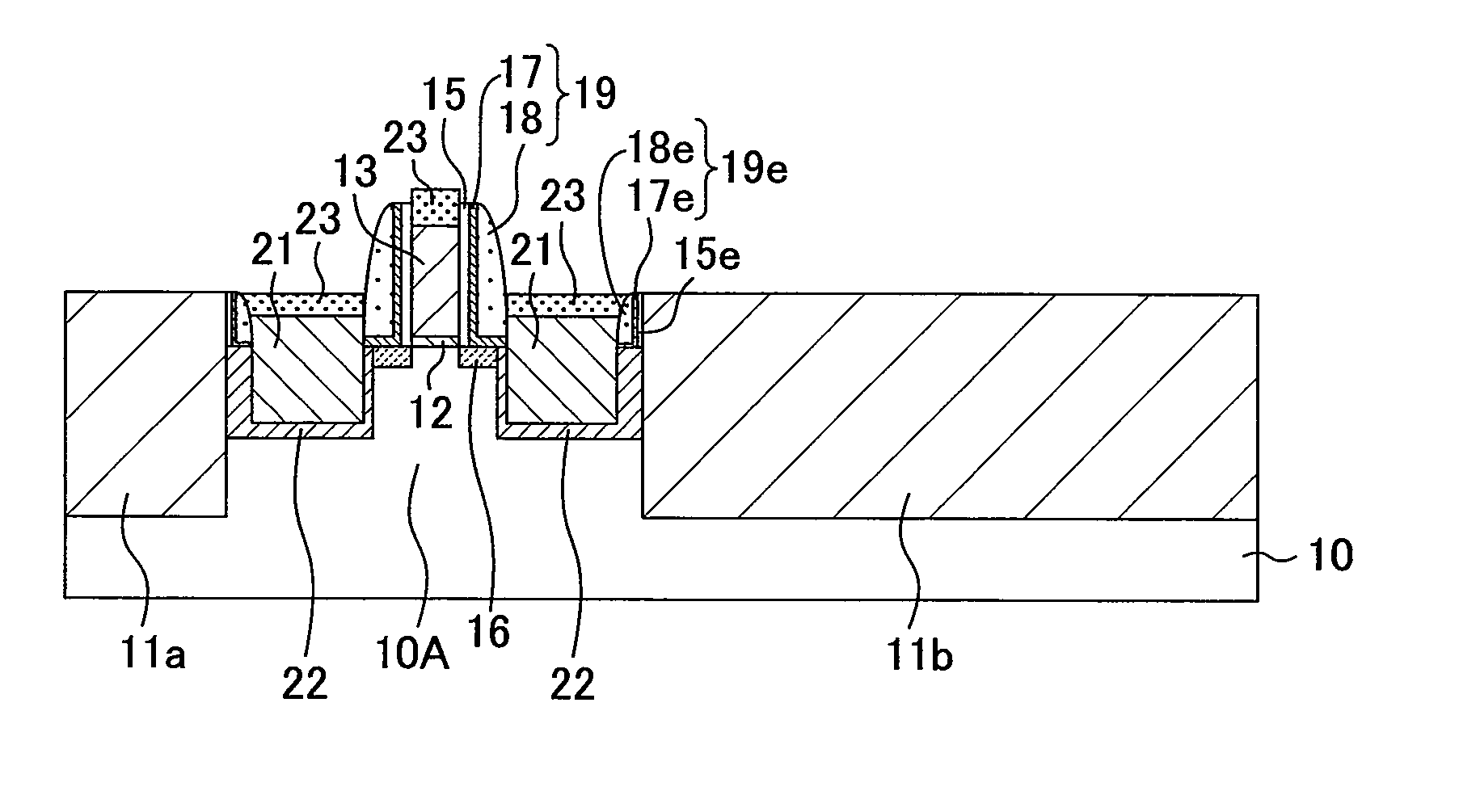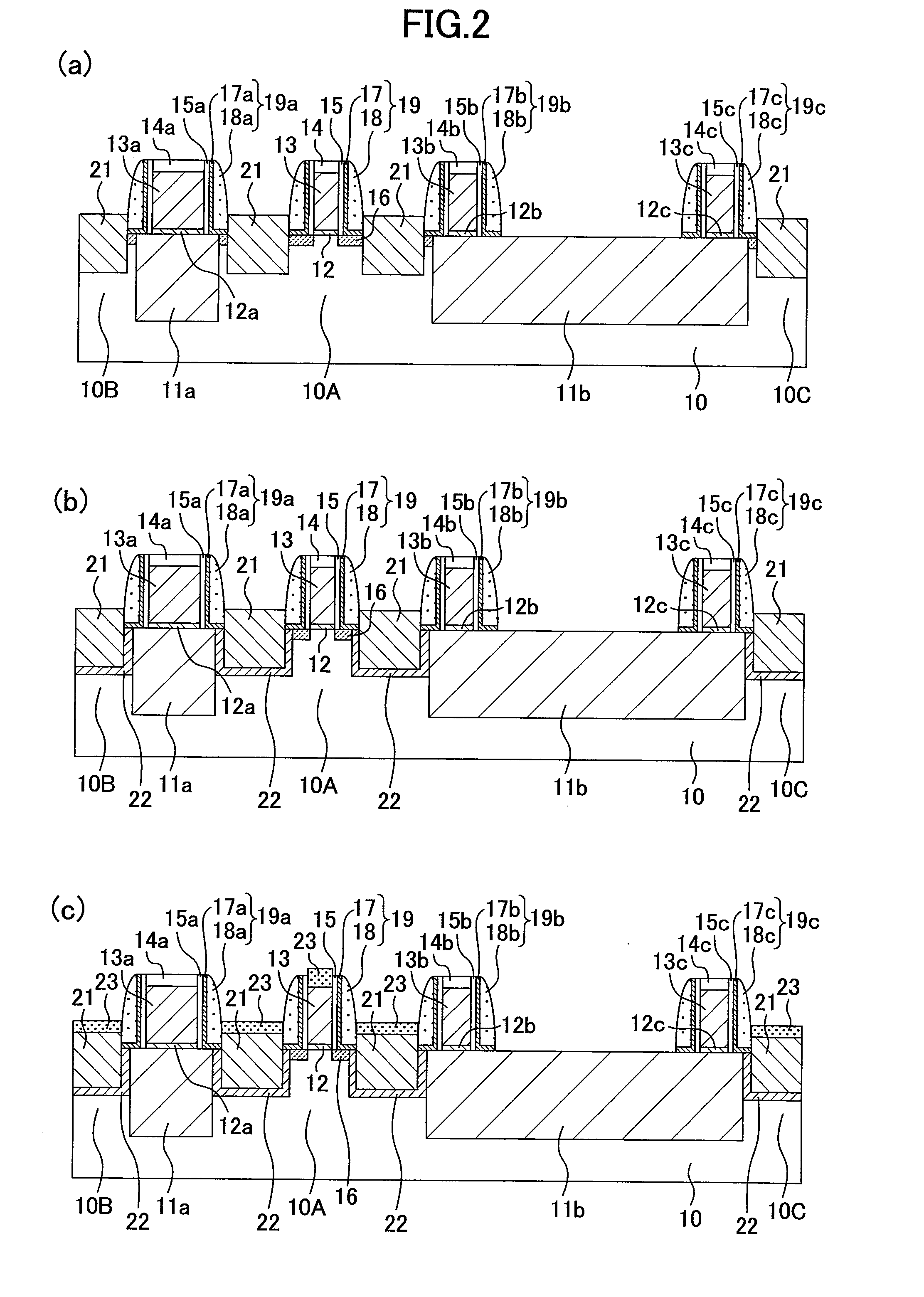Semiconductor device and method for fabricating the same
a semiconductor and device technology, applied in the direction of semiconductor devices, basic electric elements, electrical equipment, etc., can solve the problem ofconsiderably technical difficulties in fabricating semiconductor devices, and achieve the effect of improving the drive capability of semiconductor devices
- Summary
- Abstract
- Description
- Claims
- Application Information
AI Technical Summary
Benefits of technology
Problems solved by technology
Method used
Image
Examples
first embodiment
[0057]A method for fabricating a semiconductor device according to a first embodiment of the present invention will be described with reference to the drawings. FIGS. 1(a) to 1(c) and FIGS. 2(a) to (c) are cross-sectional views showing the method for fabricating the semiconductor device of this embodiment.
[0058]Initially, as shown in FIG. 1(a), trenches are formed in an upper portion of a semiconductor substrate 10 made of silicon (Si) with a main surface having, for example, a (100) plane orientation by, for example, STI (Shallow Trench Isolation). The trenches are filled with an insulating film to selectively form isolation regions 11a and 11b. As a result, active regions 10A, 10B and 10C that are made of the semiconductor substrate 10 and are surrounded by the isolation regions 11a and 11b are formed. Here, an isolation width of the isolation region 11a is narrower than that of the isolation region 11b, and is twice to five times as long as a gate length of a gate electrode as a ...
second embodiment
[0105]A method for fabricating a semiconductor device according to a second embodiment of the present invention will be described with reference to the drawings. FIGS. 6 and 7 are cross-sectional views showing the method for fabricating the semiconductor device of this embodiment. Note that the same parts as those of the first embodiment (FIGS. 1 and 2) are indicated by the same reference characters and will not be described in more detail.
[0106]Initially, as shown in FIG. 6(a), trenches are formed in an upper portion of a semiconductor substrate 10 made of silicon (Si) with a main surface having, for example, a (100) plane orientation by, for example, STI (Shallow Trench Isolation). The trenches are filled with an insulating film to selectively form isolation regions 11a and 11b. As a result, an active region 10A that is made of the semiconductor substrate 10 and is surrounded by the isolation regions 11a and 11b are formed.
[0107]Next, an n-type well region (not shown) is formed by...
third embodiment
[0125]A method for fabricating a semiconductor device according to a third embodiment of the present invention will be described with reference to the drawings. FIGS. 9 and 10 are cross-sectional views showing the method for fabricating the semiconductor device of this embodiment. Note that the same parts as those of the first embodiment (FIGS. 1 and 2) are indicated by the same reference characters and will not be described in more detail.
[0126]Initially, as shown in FIG. 9(a), a gate insulating film 12, a gate electrode 13 and a protective insulating film 14 are formed on an active region 10A surrounded by isolation regions 11a and 11b in a semiconductor substrate 10 in a manner similar to the step of FIG. 6(a) in the second embodiment. Next, offset spacers 15 are formed on side surfaces of the gate electrode 13, and thereafter, p-type extension regions 16 are formed in regions on sides of the gate electrode 13 of the active region 10A.
[0127]Next, as shown in FIG. 9(b), for exampl...
PUM
 Login to View More
Login to View More Abstract
Description
Claims
Application Information
 Login to View More
Login to View More - R&D
- Intellectual Property
- Life Sciences
- Materials
- Tech Scout
- Unparalleled Data Quality
- Higher Quality Content
- 60% Fewer Hallucinations
Browse by: Latest US Patents, China's latest patents, Technical Efficacy Thesaurus, Application Domain, Technology Topic, Popular Technical Reports.
© 2025 PatSnap. All rights reserved.Legal|Privacy policy|Modern Slavery Act Transparency Statement|Sitemap|About US| Contact US: help@patsnap.com



